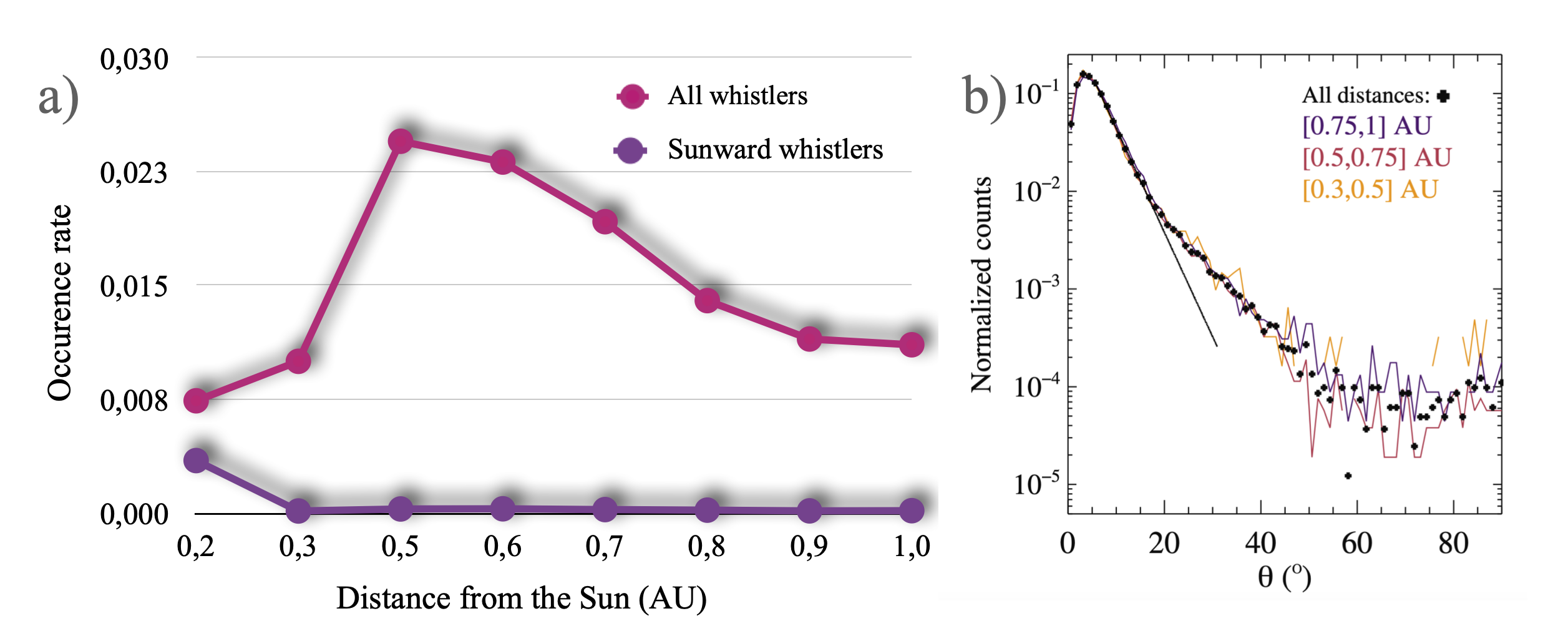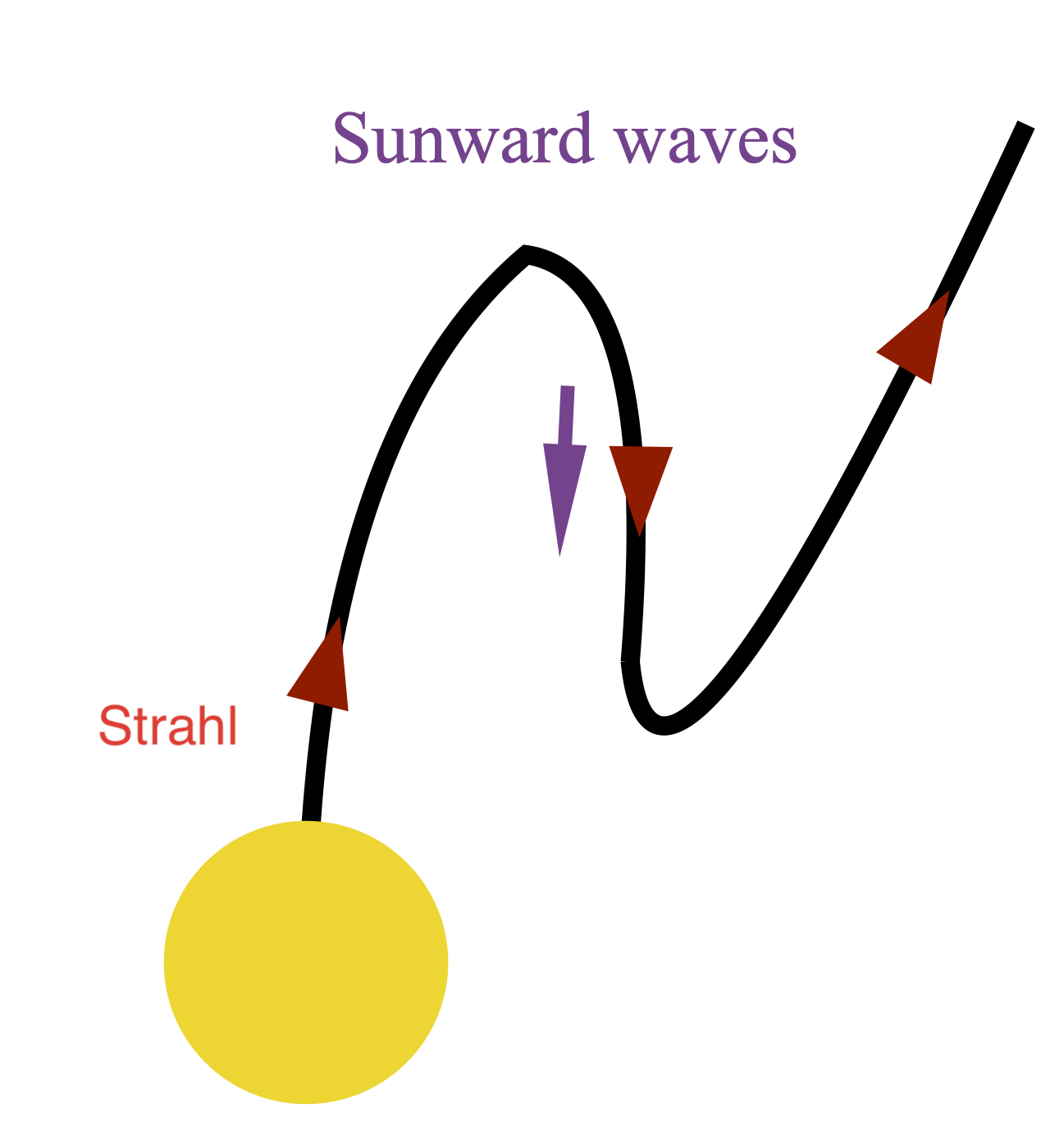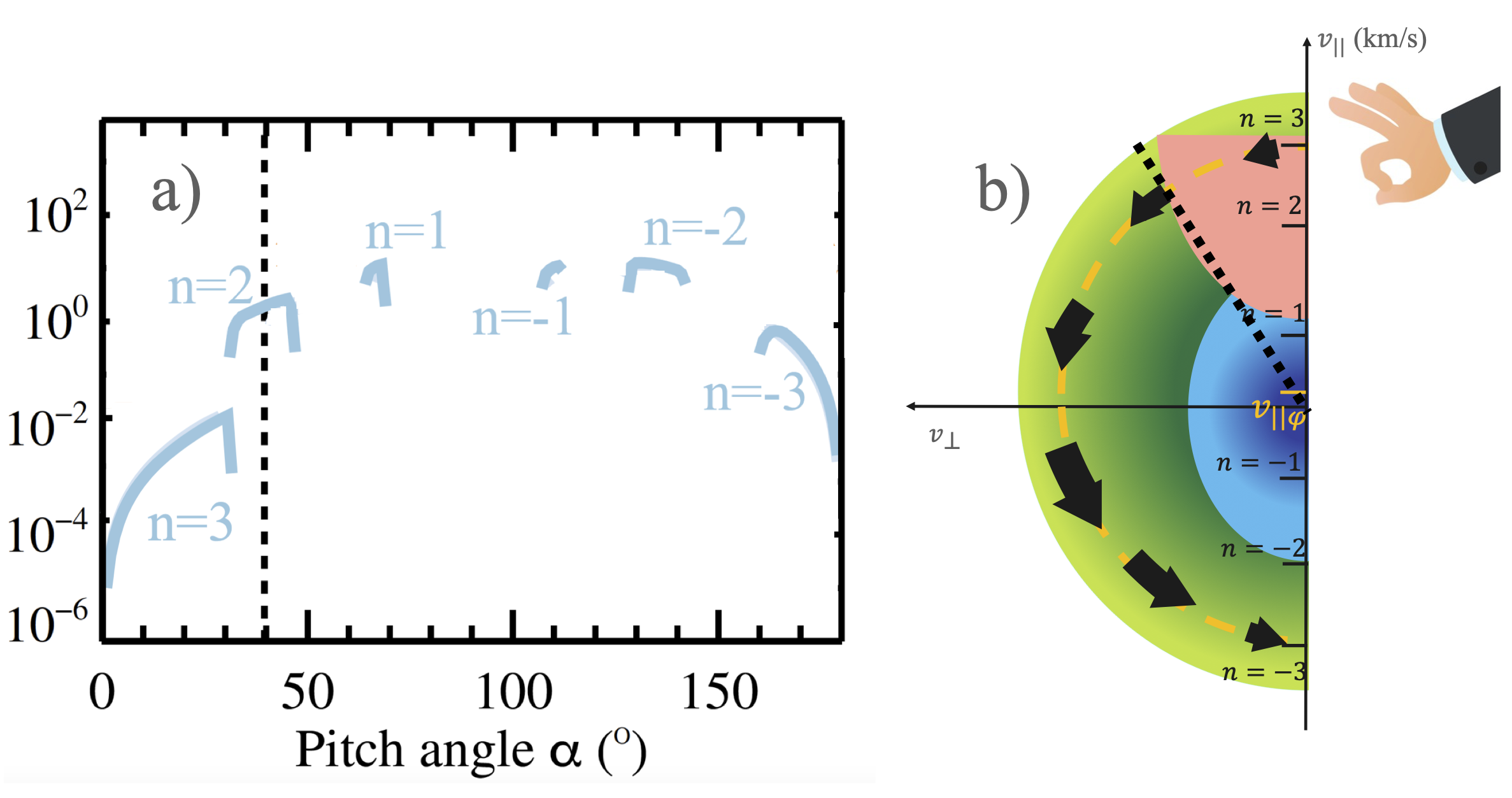Science nugget: Quantifying the diffusion of suprathermal electrons by whistler waves with Solar Orbiter - Solar Orbiter
Quantifying the diffusion of suprathermal electrons by whistler waves between 0.2 and 1 AU with Solar Orbiter and Parker Solar Probe
(Solar Orbiter Nugget #33 by L. Colomban1, M. Kretzschmar1, V. Krasnoselkikh1,2, O. V. Agapitov2,3, C. Froment1, M. Maksimovic4, M. Berthomier5, Yu. V. Khotyainsev6, D. B. Graham6 and S. Bale2,7)
Introduction
In the solar wind, it is common to distinguish three categories of electron populations. The core represents the thermal electrons at low energies [1–3]. The suprathermal electrons of the halo have higher energies and are often represented by kappa distributions [4–6]. The Strahl is a beam of high-energy electrons that follows the magnetic field lines, propagating in the anti-sunward direction [1].
The evolution of these populations with heliocentric distance exhibits different features that are still unexplained. In particular, the angular width of the Strahl increases with distance, which is linked to an increase in the relative proportion of the halo [2,3,7–9]. These evolutions cannot be explained by an adiabatic propagation or by Coulomb collisions [10,11]. Wave-particle interactions between electrons and whistler waves have often been proposed to explain these phenomena [12–16].
Here we used Solar Orbiter and Parker Solar Probe observations together with quasi-linear theory to quantify the diffusion of Strahl electrons by whistler waves between 0.2 AU and 1 AU.
Whistler wave statistics
The interactions between whistler waves and Strahl electrons depend on the polarization parameters of the waves. The most important parameters are the angle of propagation relative to the magnetic field and the radial direction of propagation (sunward or anti-sunward). Oblique or sunward waves are very effective in diffusing the Strahl [13,15]. Numerous theoretical and numerical studies have predicted the important role of oblique waves in the Strahl scattering [13–16].
In this study, we use data from Solar Orbiter and Parker Solar Probe to measure polarization parameters and wave occurrence. More than 110,000 whistler wave packets are detected and analyzed, which is the largest statistical study of whistler waves in the solar wind to date.

Figure 1: Panel a): Whistler wave occurrence as a function of heliocentric distance. Panel b): Normalized histogram of the number of whistler waves as a function of the propagation angle for different heliocentric distances.
Figure 1a shows that the occurrence rate increases from 1 to 0.6 AU and decreases from 0.6 to 0.2 AU, and that sunward waves begin to appear around 0.2 AU. There are virtually no very oblique waves (θ≥70°) and most whistler waves are quasi-aligned with the magnetic field (Figure 1b). Indeed, only 7.5% of the waves have a propagation angle larger than 15°. Between 15° and up to 45°, one can notice a slight change in the slope of the distribution with respect to smaller angles; this is accompanied by changes in the amplitude, phase speed, and duration (not shown). These slightly oblique waves are interesting because they can interact more efficiently with the Strahl than quasi-aligned waves. Some sunward whistlers are present between 0.3 and 1 AU (not visible in Figure 1a) but are associated with switchbacks exhibiting a complete reversal of the radial component. Such a configuration is illustrated in Figure 2. As depicted, these sunward waves actually propagate in the same direction as the Strahl and do not interact with Strahl electrons as real counter-streaming waves. To keep this distinction in mind when discussing the impact of waves on suprathermal electrons, we propose to use the distinctive terms Strahl-aligned waves and counter-streaming whistler waves.

Figure 2: Sunward waves observed above 0.3 AU are actually aligned with Strahl electrons.
Diffusion of Strahl electrons by Whistler waves
To estimate the time scale of the electron diffusion in the velocity space we calculate the diffusion coefficients in the framework of quasi-linear theory [17–19].
These coefficients are computed from the characteristics of the waves and take into account their polarization properties, their amplitudes, and the resonant conditions of wave-particle interactions. We describe each wave packet encounter by a "kick widening":, where the index i numerates wave packet. We sum the effect of these small kicks along the electron propagation in the solar wind, taking into account the observed wave properties and occurrence, to obtain the total diffusion Da.
Da is shown in Figure 3a. The observed Strahl pitch angle width is indicated by a black dotted vertical line and the numbers correspond to the resonance orders. We can see that the total effect of the diffusion at the observed pitch angle width is of the order of a few degrees (on 0.1 AU), which is of the order of magnitude expected by the measurement of the electron distribution function. This scattering is mainly due to the slightly oblique waves, which are therefore responsible for the increase in the angular width of the Strahl.
The process of electron diffusion by the kicking of whistler waves is shown in Figure 3b. The arrow at the Strahl pitch angle width represents the Strahl diffusion and the transfer of electrons from the Strahl to the halo.

Figure 3: Integrated effect of whistler waves on Strahl electron diffusion Panel a): Integrated diffusion coefficients. Panel b): Scheme of the evolution of the electron velocity distribution function in the velocity plane and its interaction with whistler waves. The blue circle represents the core electrons, the green circle the halo electrons, and the red/pink beam the Strahl electrons. The hand represents the "small kicks". The resonance orders are indicated. One of the single-wave characteristics (centered around v_(φ||), the phase speed) is represented by an orange dotted line. The path of the diffusing electrons is indicated by the arrows. This diffusion takes place around parallel resonance speeds. The black dotted line represents the Strahl pitch angle width.
Acknowledgments
L.C, M.K, V.K, C.F, M.M, and M.B acknowledge CNES, which supported this work and the development of RPW and SWA/EAS on Solar Orbiter and FIELDS/SCM on Parker Solar Probe. The UK Space Agency (grant ST/T001062/1) supports the Solar Orbiter's magnetometer operations. The Solar Orbiter SWA research at UCL/MSSL is currently supported by the STFC grants ST/T001356/1 and ST/S000240/1. Johns Hopkins Applied Physics Laboratory designed, built, and operates, Parker Solar Probe (contract NNN06AA01C). Parker Solar Probe is part of NASA’s Living with a Star (LWS) program. We thank the FIELDS and the RPW teams for providing the data. The data used in this work can be found in the Solar Orbiter archive (http://soar.esac.esa.int/soar/) and NASA CDAWeb (https://cdaweb.gsfc.nasa.gov/index.html).
Affiliations
- LPC2E, CNRS/University of Orléans/CNES, 3A avenue de la Recherche Scientifique, Orléans, France
- Space Sciences Laboratory, University of California, Berkeley, CA, USA
- Astronomy and Space Physics Department, National Taras Shevchenko University of Kyiv, Kyiv, Ukraine
- LESIA, Observatoire de Paris, Université PSL, CNRS, Sorbonne Université, Université de Paris, Meudon, France
- LPP, CNRS, Ecole Polytechnique, Sorbonne Université, Observatoire de Paris, Université Paris-Saclay, Palaiseau, Paris, France
- Swedish Institute of Space Physics (IRF), Uppsala, Sweden
- Physics Department, University of California, Berkeley, CA, USA
References
- Pilipp WG, Miggenrieder H, Montgomery MD, Mühlhäuser KH, Rosenbauer H, Schwenn R. Characteristics of electron velocity distribution functions in the solar wind derived from the Helios Plasma Experiment. J Geophys Res. 1987;92(A2):1075. doi:10.1029/JA092iA02p01075
- Maksimovic M, Zouganelis I, Chaufray JY, et al. Radial evolution of the electron distribution functions in the fast solar wind between 0.3 and 1.5 AU. J Geophys Res. 2005;110(A9). doi:10.1029/2005JA011119
- Štverák Š, Maksimovic M, Trávníček PM, Marsch E, Fazakerley AN, Scime EE. Radial evolution of nonthermal electron populations in the low-latitude solar wind: Helios, Cluster, and Ulysses Observations. J Geophys Res. 2009;114(A5):n/a-n/a. doi:10.1029/2008JA013883
- Feldman WC, Asbridge JR, Bame SJ, Montgomery MD, Gary SP. Solar wind electrons. J Geophys Res. 1975;80(31):4181-4196. doi:10.1029/JA080i031p04181
- Feldman WC, Asbridge JR, Bame SJ, Gosling JT, Lemons DS. Characteristic electron variations across simple high-speed solar wind streams. J Geophys Res. 1978;83(A11):5285. doi:10.1029/JA083iA11p05285
- Lazar M, Pierrard V, Poedts S, Fichtner H. Characteristics of solar wind suprathermal halo electrons. A&A. 2020;642:A130. doi:10.1051/0004-6361/202038830
- Hammond CM, Feldman WC, McComas DJ, Phillips JL, Forsyth RJ. Variation of electron-strahl width in the high-speed solar wind: Ulysses observations. Published online 1996.
- Berčič L, Maksimovic M, Landi S, Matteini L. Scattering of Strahl Electrons in the Solar Wind between 0.3 and 1 au: Helios Observations. Monthly Notices of the Royal Astronomical Society. 2019;486(3):3404-3414. doi:10.1093/mnras/stz1007
- Graham GA, Rae IJ, Owen CJ, et al. The evolution of solar wind strahl with heliospheric distance. J Geophys Res Space Physics. 2017;122(4):3858-3874. doi:10.1002/2016JA023656
- Berčič L, Landi S, Maksimović M. The Interplay Between Ambipolar Electric Field and Coulomb Collisions in the Solar Wind Acceleration Region. Journal of Geophysical Research: Space Physics. 2021;126(3):e2020JA028864. doi:10.1029/2020JA028864
- Boldyrev S, Horaites K. Kinetic theory of the electron strahl in the solar wind. Monthly Notices of the Royal Astronomical Society. 2019;489(3):3412-3419. doi:10.1093/mnras/stz2378
- Vocks C, Salem C, Lin RP, Mann G. Electron Halo and Strahl Formation in the Solar Wind by Resonant Interaction with Whistler Waves. ApJ. 2005;627(1):540-549. doi:10.1086/430119
- Vasko IY. Whistler Fan Instability Driven by Strahl Electrons in the Solar Wind. The Astrophysical Journal Letters. Published online 2019:7.
- Verscharen D, Chandran BDG, Jeong SY, Salem CS, Pulupa MP, Bale SD. Self-induced Scattering of Strahl Electrons in the Solar Wind. ApJ. 2019;886(2):136. doi:10.3847/1538-4357/ab4c30
- Cattell C, Vo T. Modeling Interactions of Narrowband Large Amplitude Whistler-mode Waves with Electrons in the Solar Wind inside ∼0.3 au and at 1 au Using a Particle Tracing Code. ApJL. 2021;914(2):L33. doi:10.3847/2041-8213/ac08a1
- Micera A, Zhukov AN, López RA, et al. Particle-In-Cell simulation of whistler heat flux instabilities in the solar wind: heat flux regulation and electron halo formation. ApJL. 2020;903(1):L23. doi:10.3847/2041-8213/abc0e8
- Vedenov AA. Quasi-linear plasma theory (theory of a weakly turbulent plasma). J Nucl Energy, Part C Plasma Phys. 1963;5(3):169. doi:10.1088/0368-3281/5/3/305
- Kennel CF, Engelmann F. Velocity Space Diffusion from Weak Plasma Turbulence in a Magnetic Field. The Physics of Fluids. 1966;9(12):2377. doi:10.1063/1.1761629
- Lyons LR. Pitch angle and energy diffusion coefficients from resonant interactions with ion–cyclotron and whistler waves. J Plasma Phys. 1974;12(3):417-432. doi:10.1017/S002237780002537X
- Removed a total of (3) style margin:0;
Nuggets archive
2025
19/03/2025: Radial dependence of solar energetic particle peak fluxes and fluences
12/03/2025: Analysis of solar eruptions deflecting in the low corona
05/03/2025: Propagation of particles inside a magnetic cloud: Solar Orbiter insights
19/02/2025: Rotation motions and signatures of the Alfvén waves in a fan-spine topology
12/02/2025: 'Sun'day everyday: 2 years of Solar Orbiter science nuggets that shed light on some of our star's mysteries
22/01/2025: Velocity field in the solar granulation from two-vantage points
15/01/2025: First joint X-ray solar microflare observations with NuSTAR and Solar Orbiter/STIX
2024
18/12/2024: Shocks in tandem : Solar Orbiter observes a fully formed forward-reverse shock pair in the inner heliosphere
11/12/2024: High-energy insights from an escaping coronal mass ejection
04/12/2024: Investigation of Venus plasma tail using the Solar Orbiter, Parker Solar Probe and Bepi Colombo flybys
27/11/2024: Testing the Flux Expansion Factor – Solar Wind Speed Relation with Solar Orbiter data
20/11/2024:The role of small scale EUV brightenings in the quiet Sun coronal heating
13/11/2024: Improved Insights from the Suprathermal Ion Spectrograph on Solar Orbiter
30/10/2024: Temporally resolved Type III solar radio bursts in the frequency range 3-13 MHz
23/10/2024: Resolving proton and alpha beams for improved understanding of plasma kinetics: SWA-PAS observations
25/09/2024: All microflares that accelerate electrons to high-energies are rooted in sunspots
25/09/2024: Connecting Solar Orbiter and L1 measurements of mesoscale solar wind structures to their coronal source using the Adapt-WSA model
18/09/2024: Modelling the global structure of a coronal mass ejection observed by Solar Orbiter and Parker Solar Probe
28/08/2024: Coordinated observations with the Swedish 1m Solar Telescope and Solar Orbiter
21/08/2024: Multi-source connectivity drives heliospheric solar wind variability
14/08/2024: Composition Mosaics from March 2022
19/06/2024: Coordinated Coronal and Heliospheric Observations During the 2024 Total Solar Eclipse
22/05/2024: Real time space weather prediction with Solar Orbiter
15/05/2024: Hard X ray and microwave pulsations: a signature of the flare energy release process
01/02/2024: Relativistic electrons accelerated by an interplanetary shock wave
11/01/2024: Modelling Two Consecutive Energetic Storm Particle Events observed by Solar Orbiter
2023
14/12/2023: Understanding STIX hard X-ray source motions using field extrapolations
16/11/2023: EUI data reveal a "steady" mode of coronal heating
09/11/2023: A new solution to the ambiguity problem
02/11/2023: Solar Orbiter and Parker Solar Probe jointly take a step forward in understanding coronal heating
25/10/2023: Observations of mini coronal dimmings caused by small-scale eruptions in the quiet Sun
18/10/2023: Fleeting small-scale surface magnetic fields build the quiet-Sun corona
27/09/2023: Solar Orbiter reveals non-field-aligned solar wind proton beams and its role in wave growth activities
20/09/2023: Polarisation of decayless kink oscillations of solar coronal loops
23/08/2023: A sharp EUI and SPICE look into the EUV variability and fine-scale structure associated with coronal rain
02/08/2023: Solar Flare Hard Xrays from the anchor points of an eruptive filament
28/06/2023: 3He-rich solar energetic particle events observed close to the Sun on Solar Orbiter
14/06/2023: Observational Evidence of S-web Source of Slow Solar Wind
31/05/2023: An interesting interplanetary shock
24/05/2023: High-resolution imaging of coronal mass ejections from SoloHI
17/05/2023: Direct assessment of far-side helioseismology using SO/PHI magnetograms
10/05/2023: Measuring the nascent solar wind outflow velocities via the doppler dimming technique
26/04/2023: Imaging and spectroscopic observations of EUV brightenings using SPICE and EUI on board Solar Orbiter
19/04/2023: Hot X-ray onset observations in solar flares with Solar Orbiter/STIX
12/04/2023: Multi-scale structure and composition of ICME prominence material from the Solar Wind Analyser suite
22/03/2023: Langmuir waves associated with magnetic holes in the solar wind
15/03/2023: Radial dependence of the peak intensity of solar energetic electron events in the inner heliosphere
08/03/2023: New insights about EUV brightenings in the quiet sun corona from the Extreme Ultraviolet Imager








































 Sign in
Sign in
 Science & Technology
Science & Technology